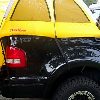My door sticker says 30psi, I inflate to 30-31psi. Also I have a functional 5th shock in rear.
I love my family, don't like to gamble with their safety.
Running 45psi? WHY? What good does? Lets you slide more in curves? Enjoy the increased number of suspension components failures?
I think most people do it for the fuel economy, not power sliding. But thanks for sharing that link, it's a very good read.
It does raise some questions though.
Does the independent front suspension have better or worse stability than the TTB setup?
Would lowering the front ride height (torsion twist) improve stability?
Would poly sway bar bushings help stability?
PS:
http://content.time.com/time/business/article/0,8599,128198,00.html
26psi was chosen to improve the grip on the road. With the Explorer's 1990 production date approaching, Ford engineers listed four options for improving the stability of the SUV: widening the chassis by 2 in.; lowering the engine; or lowering the tire pressure and stiffening the springs. Ford chose the latter two fixes and recommended a tire pressure of 26 p.s.i.—rather than the 30-to-35 p.s.i. that Firestone normally used in its tires—to produce a more road-gripping ride.
http://www.nber.org/digest/aug03/w9524.html
Workers at a Firestone plant in Illinois were on strike during the time many of the 6.5 million tires now being recalled were made, according to an analysis by Ford Motor Co.
"When we looked at this data, we said, `There's something wrong here,'" Jason Vines, Ford's vice president for communications, said during a teleconference Sunday with reporters and tire company officials.
Most of the tires recalled last week -- radial ATX, radial ATX II and some Wilderness AT brands -- are on Ford sport utility "vehicles and light trucks. And most of those tires were built at the Decatur, Ill., plant from 1994 to 1996".
The Decatur plant, by May 1995, employed 1048 replacement workers and 371 permanent workers who crossed the picket line. The union unconditionally agreed to return to work that month, and by 1996 a majority of the workforce in the Decatur plant was made up of strikers who had returned to work. A month-by-month analysis reveals that the excess number of defect claims for tires from the Decatur plant reached a peak for tires made in the beginning of 1996.
Four years after they were produced, P235 tires made in Decatur during the labor dispute were some 15 times more likely to have resulted in a financial claim against the company than were tires manufactured in other plants. Before the recall, these tires had a fatal accident rate of 10 to 30 per million tires produced. A settlement was ratified in December 1996, and the number of defects began to abate at the Decatur plant.[/QUOTE]










